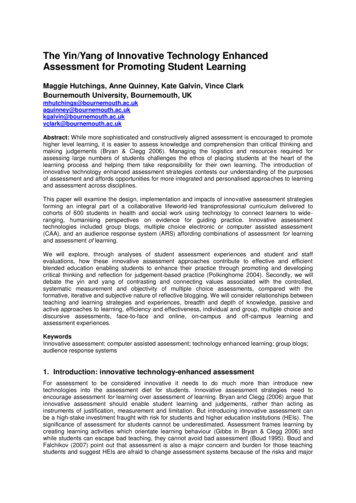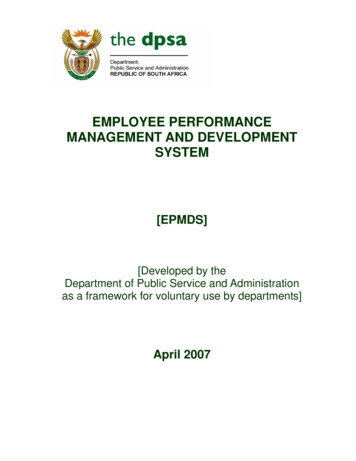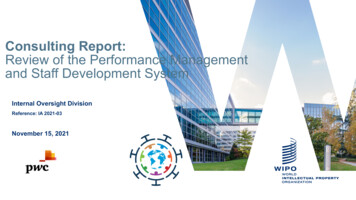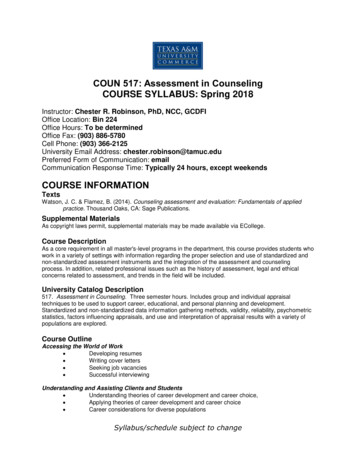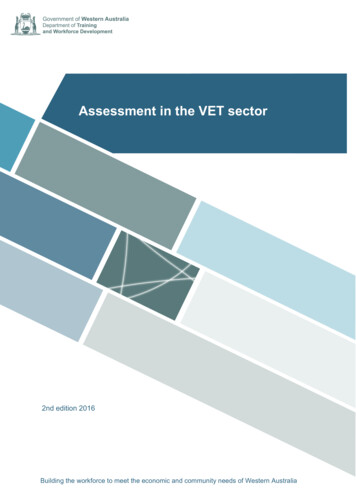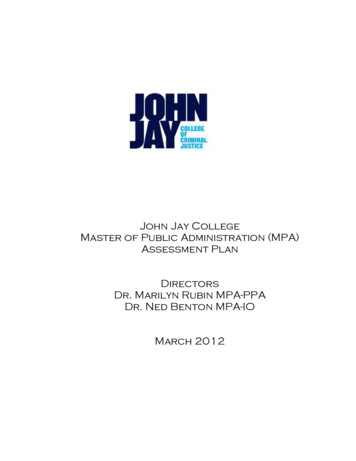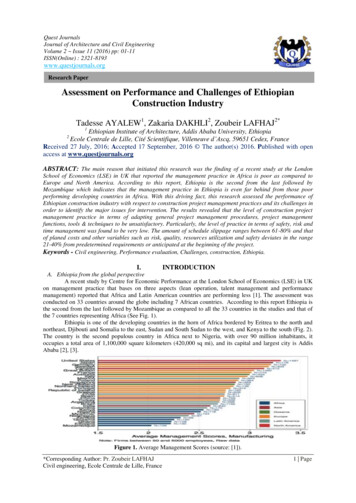
Transcription
Quest JournalsJournal of Architecture and Civil EngineeringVolume 2 Issue 11 (2016) pp: 01-11ISSN(Online) : 2321-8193www.questjournals.orgResearch PaperAssessment on Performance and Challenges of EthiopianConstruction IndustryTadesse AYALEW1, Zakaria DAKHLI2, Zoubeir LAFHAJ2*1Ethiopian Institute of Architecture, Addis Ababa University, EthiopiaEcole Centrale de Lille, Cité Scientifique, Villeneuve d’Ascq, 59651 Cedex, FranceReceived 27 July, 2016; Accepted 17 September, 2016 The author(s) 2016. Published with openaccess at www.questjournals.org2ABSTRACT: The main reason that initiated this research was the finding of a recent study at the LondonSchool of Economics (LSE) in UK that reported the management practice in Africa is poor as compared toEurope and North America. According to this report, Ethiopia is the second from the last followed byMozambique which indicates that the management practice in Ethiopia is even far behind from those poorperforming developing countries in Africa. With this driving fact, this research assessed the performance ofEthiopian construction industry with respect to construction project management practices and its challenges inorder to identify the major issues for intervention. The results revealed that the level of construction projectmanagement practice in terms of adapting general project management procedures, project managementfunctions, tools & techniques to be unsatisfactory. Particularly, the level of practice in terms of safety, risk andtime management was found to be very low. The amount of schedule slippage ranges between 61-80% and thatof planed costs and other variables such as risk, quality, resources utilization and safety deviates in the range21-40% from predetermined requirements or anticipated at the beginning of the project.Keywords - Civil engineering, Performance evaluation, Challenges, construction, Ethiopia.I.INTRODUCTIONA. Ethiopia from the global perspectiveA recent study by Centre for Economic Performance at the London School of Economics (LSE) in UKon management practice that bases on three aspects (lean operation, talent management and performancemanagement) reported that Africa and Latin American countries are performing less [1]. The assessment wasconducted on 33 countries around the globe including 7 African countries. According to this report Ethiopia isthe second from the last followed by Mozambique as compared to all the 33 countries in the studies and that ofthe 7 countries representing Africa (See Fig. 1).Ethiopia is one of the developing countries in the horn of Africa bordered by Eritrea to the north andnortheast, Djibouti and Somalia to the east, Sudan and South Sudan to the west, and Kenya to the south (Fig. 2).The country is the second populous country in Africa next to Nigeria, with over 90 million inhabitants, itoccupies a total area of 1,100,000 square kilometers (420,000 sq mi), and its capital and largest city is AddisAbaba [2], [3].Figure 1. Average Management Scores (source: [1]).*Corresponding Author: Pr. Zoubeir LAFHAJCivil engineering, Ecole Centrale de Lille, France1 Page
Assessment on Performance and Challenges of Ethiopian Construction IndustryFigure 2. Description of the study area Ethiopia (Source: http://www.operationworld.org/ethi)B. Ethiopian Construction IndustryBased on [4], the Ethiopian construction industry can be viewed in six distinct periods for its evolution.The following table summarizes these distinct periods and their feature.Table 1. Summary of Ethiopian construction industry six district periods. (Adapted from [4]).PeriodPre inationEmergence of small iesdomination1987-1991Fragmentation of Phases1991-2001Era for Re-emergency ofprivatizationSince 2001Emergency of Integrationand capacity buildingThe Feature of Each PeriodsThis was a period where almost all construction activities in thecountry were undertaken by international construction companiesA period that encourages private sector development, which results inestablishment of small-scale domestic construction companies in thecountry.This period was known as parastatal company domination periodsince the government has taken the private construction company thatwas established earlier and those state owned construction firmsundertook almost all construction activities.During this period design services and construction phases wasintroduced as a separate phase to Ethiopian construction industry.The year 1989 brings another change in government with completelydifferent policies that re-emerge private sector development. As aresult of this a number of private construction companies wereestablished in the country and started taking parts in manyconstruction activities.Realizing the performance and capacity limitation of domestic firms,which begins to be involved in some projects, the government hasintroduced the concept of integration and capacity building in 2001.The construction industry in Ethiopia has been developing tremendously since 2001. Recent studies by(Zewdu & Aregaw 2015) indicated that the GDP contribution of the industry has been raised to 5.6% andapproaches to the sub Saharan average (6%). Meanwhile, the Gross Domestic Capital Formation (GDCF),which was about 60 percent in 1996/97, has reached nearly 75% in 2002/03. Beyond its contribution to thenation, the industry is also the 6th major contributor of the content infrastructure stock following South Africa,Egypt, Morocco, Algeria and Nigeria [5].Since then, the country has been implementing significant number of programs/projects, which includethe University Capacity Building Program (UCBP), the housing development program and the road sectorprograms among others. Table 2 summarizes the major construction projects undertaken during this period.*Corresponding Author: Pr. Zoubeir LAFHAJ2 Page
Assessment on Performance and Challenges of Ethiopian Construction IndustryTable 2. Summary of Major Construction Projects in Ethiopia during this iversitycapacitybuilding ProgramIt was a program with an objective of constructing 13 universityprojects together with capacity development of domestic constructionand consulting firms. The program was designed and implementedwith involvement of GTZ IS as a project-implementing agent.This was a program that aims to construct 450,000 housing units in 5years in the capital and creating employment opportunity for smalland medium scale enterprises.A 13 years program that was planned to implement 38,080 Km ofroad together with capacity building of domestic construction andconsulting firms. At the end of the 13 years the program wassucceeded to accomplish 105% of its target (39,965km).In addition to road infrastructure the country has also identifiedpotential railway corridors to connect the capital with major cities.Currently there are two active railway projects in Ethiopia: The LightRailway Transit in the capital and the Addis Ababa- Djibouti rail waythat connects the capital to the port of Djibouti.These are hydropower projects constructed for the last two decades togenerate 3,230 MW of electricity. Except Gilegel Gibe III all of theseprojects are completed some years back and started functioning.Besides the above hydropower projects, the country is alsoundertaking the construction of the great renaissance dam (GRD)which is expected to generate 600GW.HousingProgramRoad andTransportdevelopmentRoadSectorDevelopment Program I-IIIRailwayEnergyGilgelGibeI-III,Tekeze and BelesTheRenascence(GRD)GreatDamGeo-Thermal ProjectThis is also one of the mega and largest Geo-thermal plant in Africalaunched at a cost of 4Billion USD recently.Despite its prominent role, the construction industry in Ethiopia, like in other developing countries,faces many challenges in its practice. Some of these challenges are project overruns, poor quality, inappropriateprocurement systems, and a failure to cope with project requirements and the inability to adopt best practices[4], [2], [6].II.CONSTRUCTION PROJECT MANAGEMENT AND ITS CHALLENGES INDEVELOPING COUNTRIESProject Management is a specialized management technique necessary for the planning, organizationand control of projects under one strong point of responsibility [7]. [8] also described Project Management asthe application of knowledge, skills, tools, and techniques to project activities in order to meet projectrequirements. On the contrary, Lack of sound Project Management by owners or contractors on projects on theother hand leads to construction delays and extra costs for both parties [9]. Similarly, [10] define professionalproject management practices as the skills and science of planning, designing, and managing activitiesthroughout the project lifecycle. In agreement with the above authors, [11] stated that Project Management isclearly designed to achieve a successful outcome of the projects and argue that if not properly practiced it mayconvey a differ result. [12] on the other hand argue that construction projects are somewhat difficult to manageand meet these requirements due to the nature of the industry; such as complex and unique nature, mobileworkforce, ingrained culture, working conditions, and project-based setup, diverse sub-contractors andsuppliers.The function of construction project management is therefore to predict as many of the risk andproblems as possible and to plan, organize and control activities so that the project is completed successfully[13].The performance of these projects against what was planned can be measured and evaluated using alarge number of performance indicators that could be related to various dimensions (groups) such as time, cost,quality, client satisfaction, business performance, health and safety [14]. They further argue that time, cost andquality are, however, the 3 predominant performance evaluation dimensions. [15] also agreed with [14] and theypointed out that cost, time and quality are the three basic and most important performance indicators inconstruction projects. [8] on the other hand stated that the application of sound Project Management practicesprovides construction project stakeholders with the means to meet their objectives which is described in terms of*Corresponding Author: Pr. Zoubeir LAFHAJ3 Page
Assessment on Performance and Challenges of Ethiopian Construction Industrymeeting the intended, purpose, the level of quality, time, cost; and safely and while protecting the environment.According to [12], [7], [16], the success of a project is measured by the extent to which it meets thepredetermined criteria of cost, time, safety, resource allocation, and quality as determined by the owner whichare quite difficult to meet in most construction projects.[17] on the other hand explains that whether an organization manages stand-alone or multiple projects,whether those projects are small or large, whether the customers are internal or external, or whether the natureof the work performed is product development, construction, design, IT, or service; most projects are difficult tomanage because of two things: first, they involve uncertainty. Second, they involve three different and opposingcommitments: Due date, budget, and content (quality and scope).[18] on his part contends that in spite of the extensive efforts that has been made to improve theperformance of the construction industries in many developing countries, the industries in these countriescontinue to face problems including poor cost, time and quality performance; lack of work opportunities andpoor level of professionalism. As it is described by [19], the main reasons for project failure in developingcountries are: lack of advance planning, a holistic approach, lack of comprehensive engineering andmanagement strategy, inconsistency in monitoring and follow-up, coordination and communication lapses andabove all, absence of a methodical approach. Extending his argument [20] further described that these factorssignificantly affect the efficient performance of construction team and in most cases lead to project failure [21].According to [18], developing countries in general fall short when compared with other sectors of theeconomy within their own countries, as well as with their counterparts elsewhere with regard to productivity,quality, safety and health, and environmental performance. Although these problems are common for mostconstruction industries in all countries, those in the developing nations face them to larger extent due to theadditional difficulties of economic stress, resource shortages, and institutional and legal which make the task ofimproving their performance even more demanding [18].C. The Extent of the Problem in Some Developing CountriesA study on cost and time overrun by [22] in Malaysia indicated that the Malaysian constructionindustry is characterized by poor performance leading to failure in achieving effective time and costperformance. The findings of this study revealed that 92% of construction projects were overrun and only 8% ofproject could achieve completion within contract duration. In terms of cost performance only 11% ofrespondents mentioned that normally their projects are finished within budgeted cost while 89% of respondentsagreed that their projects were facing the problem of time and cost overrun in the range of 5-10% of contract.Another study by [23] in Malaysia on the other hand concluded that only 46.8% and 37.2% of publicsector and private sector projects respectively are completed within the budget. The study by [24] also contendsthe same idea: 9 out of 10 transportation infrastructure projects costs are underestimated and that for all projecttypes, the actual costs are on average 28% higher than estimated costs. The situation seems to be worse in Indiawhere studies on construction projects, found that more than 60% of projects experienced up to 200% timeoverrun and 750% cost overrun [25].D. The Extent of the Problem in Some Selected African CountriesMost of these challenges are also observed in many African developing countries such as Nigeria,Kenya, Ghana, Uganda and Tanzania. [25] in Tanzania found out that total cost and time overrun rates onaverage to be 44% and 26% respectively by considering seven projects. [25]further identified that among otherfactors the average contribution of inadequate design to be 26% and 32% respectively and the extent to whichinadequate design contributes, as a percentage, to cost and time overruns was 61% and 85% respectively.The case in Ghanaian construction industry as it is highlighted by [26] has also several of thecharacteristics of construction industries in developing countries. According to [26] the industry’s performancein most respects, such as cost, time, quality, safety and health of its workers, the durability of its products andthe satisfaction of its stakeholders is inadequate.The Nigerian construction industry is also still struggling with a lot of intrinsic challenges, rangingfrom inadequate technical and managerial know-how to insufficient financial, material and equipment capitalbase [27]. A study on evaluation of management challenges facing the Nigerian construction industry alsorevealed that time; cost, quality, and safety remain the top management challenges facing construction managersin Nigeria [12].The case in Kenya is also not different with other most of African countries. The industry is facing lotsof challenges such as the expenditure exceeding the budget, delay to complete the project in time, the buildingdefects and over-reliance on foreign workers. Most construction projects especially road infrastructure in Kenyaare exposed to extreme cost escalation to the extent that it calls not only for extra funding but also specializedexpertise hence leading to technical and project managerial conflicts between project's parties [28].[29] in his study in Botswana on the other hand investigated that seven out of ten public projects hadreported cost overruns and the factors that influence cost overruns have been identified and ranked in order of*Corresponding Author: Pr. Zoubeir LAFHAJ4 Page
Assessment on Performance and Challenges of Ethiopian Construction Industrysignificance, accordingly variations, re-measurement of provisional works, contractual claims and fluctuationsin the cost of labor and materials, with variations being the most significant. He also cited a recent study inwhich only 16% of the projects were considered successful (i.e. completed on time, within budget, and tospecification).III.RESEARCH METHODOLOGYThe study approach involves both literature search and the use of structured questionnaire, which wasconsidered to be the most appropriate tool to reach the population of the study with limited time and from adistance at a time. The literature review was conducted to extract the variables for the assessment and to have aconceptual bases on the subject matter. Accordingly, the survey was designed based on variables extracted fromliteratures and organized in three parts which include questions related to respondent profiles, performancerelated issues and management challenges.The designed survey were then sent to 135 professionals selected through stratified random samplingfrom academic institution, owner’s origination, implementing agencies, construction and consulting firms in thefollowing proportions in Addis Ababa in order to reach majority of the companies and more experiencedprofessionals: 21 to client; 38 to consultants; and 46 to contractors, 15 to academician and 15 to others. Out ofthe 135 questionnaires distributed, 81 were received and only 69 were duly completed and found suitable foranalysis, representing a responses rate of 51.11%.The data obtained from the survey was analyzed using mean score together with standard deviation inorder to rank the level of project management practices and major management challenges facing the industry.The output of the analyzed data is presented using tables, graphs and simple percentage for furtherinterpretation.IV.RESULTS AND DISCUSSIONE. Respondent BackgroundAs it can be observed from Figure 3 below, the distribution of the response is 70% from contractorsand consultants (35% each), 18% from academicians and implementing agents (which is 9% each) and 11%from clients. In terms of experience, more than 66% of the respondents have more than 10 years’ professionalexperiences in the industry.Figure 3. Respondent Profile by: a) type of firm, b) professional experience.F. Project Management Practice in Ethiopian Construction IndustryFollowing their profile identification, respondents were asked about their experiences in GeneralProject Management Practices; mainly to what extent they practiced project management functions, tools &techniques, adapting construction project management procedures and some other important aspects ofconstruction management practices such as quality, safety and contract management etc. The respondents wereasked to note each parameter as follow: 1. Very low 2. Low 3. Medium 4. High 5. Very High. Table 3 presentsthe results of this question. The response revealed that the level of practice on these project management aspectsin general and that of safety (1.59), risk (1.84) and time (2.07) in particular is very low.*Corresponding Author: Pr. Zoubeir LAFHAJ5 Page
Assessment on Performance and Challenges of Ethiopian Construction IndustryTableau 3. Response on Project Management PracticesMeanScoreStandardDev.RankGeneral Construction Project Management Practices (Extent ofApplication of Project Management Functions, Tools and Techniques)2.250.654General Construction Project Management Practices (State of Adoptionand Implementation of Construction Project Management Procedures)2.280.615Risks Management Performance – Stake Holders Perception, Trend,Identification of Causes of Risks and their Responsibility Allocation1.840.632Delay Management Practices – Identifying/Understanding Causes ofDelays and Delay Responsibility Allocation2.070.753Safety Culture – Perceptions and Practices1.590.641Quality Culture – Perceptions and PracticesConstructability Practices2.530.7262.680.788Contract Management Practices2.810.589Bid Procurement Practices3.060.710Addressing Client Satisfaction2.670.727Project Management PracticesThe results agreed with [18] who identified safety and time performance as a major shortcoming ofconstruction industry in developing countries. A study on cost and time overrun by [22] in Malaysia alsorevealed similar trends in Malaysian construction industry which is characterized by poor performance thatleads to failure in achieving effective time and cost performance. [7] has also identified that constructionprojects as full of risk which is very difficult to anticipate in advance due to its complex nature as well as theinvolvement of many participants. [30] on the other hand described that construction projects have oftensuffered from high fragmentation, large waste, poor productivity, cost and time overruns which leads to longterm disputes in some cases. In agreement with others [31] also pointed out that poor construction managementas one of the major causes of cost and schedule overruns that can eventually lead to the extent of total projectabandonment.The survey result also revealed that the level of application of General Project Management Functions,tools & techniques (2.25) and that of adapting construction project management procedures (2.28) areunsatisfactory. This result also agreed with the findings of [19] who identified the main reasons for projectfailure in developing countries as lack of advance planning, a holistic approach, lack of comprehensiveengineering and management strategy, inconsistency in monitoring and follow-up, coordination andcommunication lapses and above all, absence of a methodical approach. It also agreed with [18] who pointed outdeveloping nations are more vulnerable to performance problems in larger extent due to the additionaldifficulties of economic stress, resource shortages, and lack of institutional and legal frame works. The findingsalso agreed with those of [32] who studied Project Management Maturity in Ethiopia and demonstrated that theprocesses maturity level is at informal level and the maturity level in terms of practice is even at basic level.*Corresponding Author: Pr. Zoubeir LAFHAJ6 Page
Assessment on Performance and Challenges of Ethiopian Construction IndustryFigure 4. Overall performance of Ethiopian construction industry in construction project practicesFigure 4 presents the perception of the respondents regarding the overall performance of Ethiopianconstruction industry in practicing the construction project management practices shown in Figure 3. 56.52 %and 37.68 % answered respectively “Poor” and “Moderate” to describe their perception. Those two categoriesadd up to 94.2% of total answers. Only one respondent chose “Other” and his written answer was written asfollow: “On transition from Poor to Moderate owing to the improvement interventions being made these days”.Those results reveals that the overall performance of the Ethiopian industry is more likely on the side of the“Poor level”. Statistically speaking, the mean is: 2.39 and the standard deviation is: 0.71 (1 stands for “VeryPoor” and 6 for “Other”).G. Management ChallengesIn this regards, respondents were asked to identify the management challenges they face whilemanaging construction projects. Table 4 presents the response on Management Challenges of the Ethiopianconstruction industry. The notation used is as follow: 1. Not at all 2. Very little extent 3. Moderate extent 4.Large extent. Accordingly, they identified time (3.3), cost (3.28), risk (3.17), resources (3.17) and safetymanagement (3.16) as the most challenging issues in managing their day to day’s activities. The result alsoreinforces the result obtained above in terms of project management practices since the management challengesare the consequences of poor practice of project management tools and techniques and lack of adaptingappropriate project management procedures.This result is in adequacy with the findings of many researchers [33], [12], [13], [34] whoacknowledged that management of construction projects from design to disposal are difficult and accompaniedwith enormous challenges. Similar study by [12] in Nigeria also identified that time (scheduling), quality, cost,safety management challenges as the top management challenges facing Nigerian Construction Industry. A fieldstudy by [7] has also confirmed that traditional measures of cost, time, scope, and quality are still majorchallenges in Kenya.A study by [35] also pointed out that the use of risk management in the Lithuanian constructionindustry is still in the range of low to moderate, with little differences between the types, sizes and risk toleranceof the organizations, and experience and risk tolerance of individuals.Tableau 4. Response on Management ChallengesMean Score Standard Dev. RankManagement ChallengesResources Management (Allocation and utilization) Challenges(Materials, Manpower, Money and Machine)Time (Scheduling) Management challengesCost Management ChallengesQuality Management ChallengesSafety Management ChallengesHandling Multiple Project Management Challenges*Corresponding Author: Pr. Zoubeir 70.81127567 Page
Assessment on Performance and Challenges of Ethiopian Construction IndustryOrganizational Management ChallengesChange Management ChallengesRisk and uncertainty Management challengesCommunication Management challenges3.073.063.172.970.750.850.950.6489310H. Extent of the ChallengesFollowing the assessment of the construction project management practice and the managementchallenges facing professionals in their day to day’s activity, respondents were also asked to indicate the extentof the problem in terms of the predominant requirements of a project (which is time, cost, quality and safety)together with risk and wastage to identify to what extent they deviate from plan or predetermined requirementsat the initial stage (Fig. 5).Accordingly the response on the extent of deviation from plan or set of requirements with respect to thepredominant performance measurements criteria, [14] revealed that the average deviation in planed cost andtime ranges between 21-40% and 61-80% respectively. And that of quality, safety and risk deviates by 21-40%from predetermined or specified requirements. In agreement with quality, cost, safety and risk, the estimatedwastage in resources utilization lies in the range of 21-40%. The extent of the problem has also agreed withmany other findings. . [24] identified 9 out of 10 transportation infrastructure projects costs are underestimatedand for all project types, the actual costs are on average 28% higher than estimated costs. They also pointed outthat the amount of waste generated in construction contributes around 30-35% of project’s production costs.[36] identified time overrun (70% of projects), cost overrun (average 14% of contract cost), and wastegeneration (approximately 10% of material cost) and they further argued that the trend is more severe indeveloping countries where these overruns sometimes exceeds 100% of the anticipated cost of the project. Thisfact is witnessed by Northern-by-pass project at Kampala which faced cost overrun of more than 100% of thecontract price.Figure 5. Range of deviation between planed (at the beginning) and actual (at completion stage) requirements.Another study by [25] in Tanzania also demonstrates the same fact, the total cost and time overrunrates on average to be 44% and 26% respectively by considering seven projects. The result also agreed with thefinding of many other researchers cited by [36] whose findings are summarized as follows; In Nigeria, out of3,407 projects only 24 projects were completed on time, while 1517 were delayed and 1812 were evenabandoned and they reported that the minimum average percentage escalation period of projects in Nigeria wasfound to be 188%. Similar research in Bosnia and Herzegovina on 177 projects found that the contracted datewas not met in 51.40 % of the projects.On top of identifying the degree of extent for each challenge, a ranking analysis was done using meanscore and the result (Fig. 6) revealed that time (3.93) and cost (2.94) as major challenge in Ethiopianconstruction industry followed by risk with a mean score of 2.90.*Corresponding Author: Pr. Zoubeir LAFHAJ8 Page
Assessment on Performance and Challenges of Ethiopian Construction Industry4.504.00Mean Score3.503.002.502.001.501.000.500.00Wastage (Time, Space, Materials, Manpower,Time OverMoneyCostrunand(Delay)OverMachinerun (Increaseetc) Qualityin Cost)DeviationSafety Risk and uncertaintyFigure 6. Ranking Based on Extent of Deviation for each challenge in the Ethiopian construction industry.The obtained results also agrees with [12] who has identified that time; cost, quality, and safety remainthe top management challenges facing construction managers in Nigeria. Similarly, [36] pointed out that theconstruction industry always faced serious and chronic problems likes time overrun, cost overrun, wastegeneration, imposing negative impacts to the environment and excessive resource consumption. Other studies bymany researchers in various developing country also witnessed the same [29], [26], [37], [25], [38].I. Potential solutionsFinally, we asked respondents to enter some potential solutions to fill the gap in the Ethiopianconstruction context. Each respondent were given 3 entries for writing his own view of the solution. With a totalcollected solutions of 151, 9 were recurrent:Apply modern project management.Stakeholders’ collaboration.Experience sharing and information cap
was established earlier and those state owned construction firms undertook almost all construction activities. 1987-1991 Fragmentation of Phases During this period design services and construction phases was introduced as a separate phase to Ethiopian construction industry. 1991-2001 Era for Re-emergency of privatization
